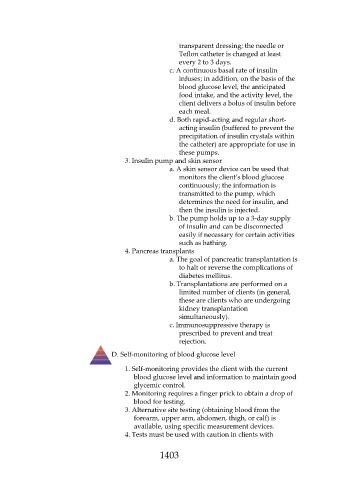Page 1403 - Saunders Comprehensive Review For NCLEX-RN
P. 1403
transparent dressing; the needle or
Teflon catheter is changed at least
every 2 to 3 days.
c. A continuous basal rate of insulin
infuses; in addition, on the basis of the
blood glucose level, the anticipated
food intake, and the activity level, the
client delivers a bolus of insulin before
each meal.
d. Both rapid-acting and regular short-
acting insulin (buffered to prevent the
precipitation of insulin crystals within
the catheter) are appropriate for use in
these pumps.
3. Insulin pump and skin sensor
a. A skin sensor device can be used that
monitors the client’s blood glucose
continuously; the information is
transmitted to the pump, which
determines the need for insulin, and
then the insulin is injected.
b. The pump holds up to a 3-day supply
of insulin and can be disconnected
easily if necessary for certain activities
such as bathing.
4. Pancreas transplants
a. The goal of pancreatic transplantation is
to halt or reverse the complications of
diabetes mellitus.
b. Transplantations are performed on a
limited number of clients (in general,
these are clients who are undergoing
kidney transplantation
simultaneously).
c. Immunosuppressive therapy is
prescribed to prevent and treat
rejection.
D. Self-monitoring of blood glucose level
1. Self-monitoring provides the client with the current
blood glucose level and information to maintain good
glycemic control.
2. Monitoring requires a finger prick to obtain a drop of
blood for testing.
3. Alternative site testing (obtaining blood from the
forearm, upper arm, abdomen, thigh, or calf) is
available, using specific measurement devices.
4. Tests must be used with caution in clients with
1403

